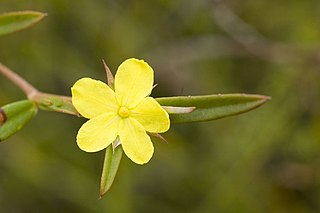Verticordia verticordina is a flowering plant in the myrtle family, Myrtaceae and is endemic to a small area near the coast of the south-west of Western Australia. It is a small, low-growing shrub with crowded leaves and in spring, scattered pale greenish-cream and golden brown flowers. Its unusual flowers and fleshy leaves give the plant a superficial resemblance to a Darwinia.
Thryptomene oligandra is a species of flowering plant in the family Myrtaceae and is endemic to northern Queensland. It is a shrub, sometimes a small tree, with decussate, egg-shaped leaves with the narrower end towards the base, and flowers with five petals and five stamens.

Eremaea acutifolia, commonly known as rusty eremaea, is a plant in the myrtle family, Myrtaceae and is endemic to the south-west of Western Australia. It is a small shrub with needle-like leaves and which bears orange-coloured flowers on short side branches and fruits with a surface that is rough to the touch.

Phymatocarpus porphyrocephalus is a plant in the myrtle family, Myrtaceae and is endemic to the south-west of Western Australia. It resembles many small species of Melaleuca, mainly differing in the way its anthers are attached at the top of the stamens. In Phymatocarpus they are attached at their base and open at the other end through two slits. It is a shrub with many small heads of pink to purple flowers fading to white, often covering the plant for several weeks in spring.
Kunzea eriocalyx is a flowering plant in the myrtle family, Myrtaceae and is endemic to a small area on the south coast of Western Australia. It is a shrub with spreading main stems with a few short side branches and which grows to a height of 0.5 to 1 metre. It blooms between August and October producing pink flowers.
Thryptomene elliottii is a species of flowering plant in the family Myrtaceae and is endemic to southern central Australia. It is a shrub with decussate, egg-shaped to club-shaped leaves and pink or white flowers with five petals and five stamens.
Thryptomene johnsonii is a species of flowering plant in the family Myrtaceae and is endemic to a restricted area of Western Australia. It is a bushy shrub with rigid branches, egg-shaped leaves with the narrower end towards the base and pink flowers with five petals and usually eight stamens.
Thryptomene naviculata is a species of flowering plant in the family Myrtaceae and is endemic to central areas of Western Australia. It is a rounded shrub with overlapping, decussate, egg-shaped leaves with the narrower end towards the base and white flowers with five petals and five stamens.

Epacris calvertiana is a plant of the heath family, Ericaceae and is endemic to New South Wales. It is an erect to diffuse shrub with elliptic to egg-shaped leaves with a sharp-pointed tip and with white, pink or red flowers arranged along the ends of leafy branchlets.

Kunzea opposita is a plant in the myrtle family, Myrtaceae and is endemic to eastern Australia. It is a spindly shrub which has small leaves arranged in opposite pairs, and pink flowers with five petals and many stamens, the stamens much longer than the petals. It usually grows in woodland or on exposed cliffs.

Leptospermum brachyandrum is a species of shrub or small tree that is endemic to eastern Australia. It has smooth bark, linear to lance-shaped leaves and white flowers and usually grows along creeks, often in water.

Rhadinothamnus euphemiae, is a slender, small, upright shrub with needle-shaped branchlets thickly covered with silvery scales and tubular greenish-purple tubular flowers throughout the year. It is endemic to the south coast of Western Australia.
Elaeocarpus grahamii is a species of flowering plant in the family Elaeocarpaceae and is endemic to north-east Queensland. It is a small to medium-sized tree, sometimes coppicing, with elliptic to egg-shaped leaves, flowers with five petals that have a frilled tip, and oval blue fruit.
Elaeocarpus sericopetalus, commonly known as hard quandong, blueberry ash, hard duandong or northern quandong, is a species of flowering plant in the family Elaeocarpaceae and is endemic to Queensland. It is a tree, sometimes with buttress roots at the base of the trunk, relatively large lenticels, oblong to elliptic leaves, creamy-white flowers with five petals, and deep red to almost black fruit.
Thryptomene longifolia is a species of flowering plant in the family Myrtaceae and is endemic to inland areas of South Australia. It is a shrub with more or less needle-shaped leaves and pink flowers with five to eight petals and five to eight stamens.

Hibbertia desmophylla is a species of flowering plant in the family Dilleniaceae and is endemic to the south-west of Western Australia. It is a sprawling or erect, hairy shrub with spreading, densely clustered, linear leaves and yellow flowers with eleven to thirteen stamens.
Hibbertia goyderi is a species of flowering plant in the family Dilleniaceae and is endemic to the Northern Territory. It is a small leafless shrub with angular stems and yellow flowers with about nine or ten stamens arranged around the two carpels.

Hibbertia salicifolia is a species of flowering plant in the family Dilleniaceae and is endemic to eastern Australia. It is a shrub with loose reddish bark, linear to oblong leaves and yellow flowers with the stamens arranged all around the carpels.

Daviesia abnormis is a species of flowering plant in the family Fabaceae and is endemic to the south-west of Western Australia. It is an erect, hairy shrub with sharply-pointed, narrow elliptic to narrow egg-shaped phyllodes with the narrower end towards the base, and yellow flowers with faint red markings.

Hibbertia spicata is a species of flowering plant in the family Dilleniaceae and is endemic to the west of Western Australia. It is a low, erect to spreading shrub with scattered linear leaves with the edges rolled under and yellow flowers with six or seven stamens on one side of two softly-hairy carpels, and a larger number of staminodes.









